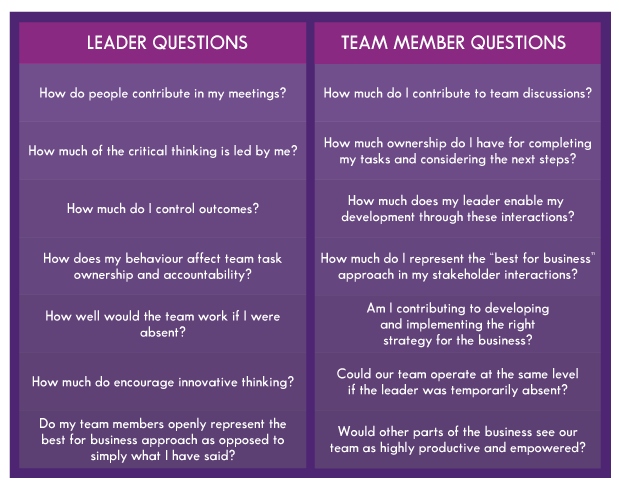
Early in my career I was a member of an executive management team and that group dynamic had some curious characteristics that I have seen at many times across my career.
As you would imagine, each team member had responsibility for a significant section of the business and this forum was used to report in on progress, plans and issues. Each member held a lot of authority in their part of the business and that was very recognisable when working in their own sections.
But – when participating in the Executive Management forum, the talents and assertiveness of the functional leaders gave way to the strength, decisiveness and wisdom on the head honcho. In fact, his influence was so great that the group had subliminally accepted that they would only ever take a task so far as he would close the loop for them either forcefully or just by habit. On many occasions, I observed concepts, plans and issues were managed to around 80 per cent of what was required and the group would palpably pause and await the divine direction required to get it across the line. Given it was always forthcoming, this behaviour remained, despite the head honcho occasionally looking concerned that he was the only one actually doing any real thinking. I certainly fell into the trap and as the youngest member of the group by around 20 years, I feel into line with this behaviour, despite thinking how dysfunctional the arrangement seemed.
Fast forward 15 years and I can still recognise elements of this behaviour in teams at varying levels and it does not look like it will stop anytime soon.
This group behaviour is closely related to the leader name-dropping phenomena that is even more common and equally illogical. Here’s how it works. A directive is created and teams are directed to execute related tasks in certain way, as explained by their leader. They treat that as gospel, even when they have reasonable queries that may change the proposed application of the tasks. Instead of taking this query back to the leader, they hold the course and deliver as told, despite knowing that as things have changed, the original plan makes less sense. If you consider the domino effect this can have in a large organisation, you very quickly realise how dangerous it can be. It’s like Chinese Whispers with a dangerous mandate.
Surprisingly, there is still a mentality that management activities need to be delivered to align to the personal preferences of an individual leader, instead of being driven by the organisations objectives or simply what is best for the business. I have lost count how many times I have heard people say “Frank’s preference is for X…” despite their body language saying “Frank doesn’t know what he’s talking about and this is a bad idea”. To me, such an approach is sure to quickly diminish the confidence of the team and equally, if the Frank knew that he is being represented in that way, he would be understandably disappointed. Furthermore, Frank would likely benefit from knowing how his plan may not work in that situation as it may help him adjust his wider strategy.
There are two ways to approach this issue and they are both driven by awareness. On one hand, you can focus on empowering and developing the team members and the team forum and the leader’s presence needs to be considered and re-positioned.
Logically, the first issue to address is not the behaviour of the group or the team members; the solution actually starts with the leader.
The leader must be aware of their leadership style and the effect it has on the team. In some cases, some leaders may be happy to see that they have total control over their team and the critical thinking completed is largely influenced by them. But, this will be at their detriment as engagement of the members will surely diminish as their attachment and accountability for their tasks cannot be connected. Equally, their unquestioning behaviour can lead to some major issues that come from not utilising the visibility that a team can give you.
So, leaders need to recognise where their style is preventing an empowered approach. Control needs to be avoided and replaced by inspiration, strategic vision and shared accountability. Awareness can come from simple observation and it can be reinforced through diagnostic tools such as 360 degree analysis or simply asking open questions to team members one-on-one. The important factor here is being open to adaptation for the greater good of the team.
In their book “Working in Teams”, Griffith and Dunham highlight some useful elements of an ideal team climate that should be considered.
The first is the presence of a “Participative safety”, which means there is enough trust and support in play to allow people to feel comfortable to participate in a way that reflects their talents. This can only exist if the leader demonstrates such behaviour and encourages it from all team members.
On a similar theme is “task orientation” which means the group members can play the ball not the man and participate in objective debate that avoids criticising individuals. Again, this type of environment can be highly productive only is the leader empowers it and guides the focus of the discussion to exclude blame and focus on collective learning.
“Support for innovation” takes this to the next step, continually encouraging open thinking and not just assigning that to a few individuals.
In their model, all of this is underpinned by a shared vision that members have ownership in the development and delivery of.
The final element that I would add is awareness. In addition to the awareness of the leader, the team members need to be aware of how they are contributing and how engaged, empowered and inspired they feel. Sometimes analysis around awareness can uncover some surprising results for both leaders and team members, so it’s worth taking the time to truly know where you stand.
Collectively, if your team members can ask the questions listed below and get positive answers, you are on your way to a productive and engaging team environment where each person can “close the loop” on their own tasks while enjoying being part of a high performing team.







